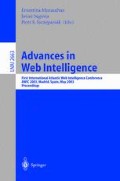Abstract
Ubiquitous computing is the method of augmenting and improving work practices and knowledge sharing, by making computers of all scales, available but invisible throughout the physical environment, while amplifying human-to-human communication. Personal systems, such as PDAs and cell phones, give users access to computing resources regardless of their location. Handheld computers are being transformed from personal electronic agendas into mobile communication devices with intermittent network connectivity. Thus, they are becoming a natural medium to tap into an ubiquitous computing infrastructure. However, handhelds most often operate disconnected from the network thus reducing the opportunities for spontaneous interoperation with other peers or web services, which is a desirable feature of ubicomp environments. Autonomous agents can enable spontaneous collaboration by representing users, as well as devices or services available through the Web, which has become an ubiquitous medium for information sharing. An agent acts on behalf of the user while he is disconnected, and represents services added to the environment, thus allowing the physical integration and interoperability of these entities. We present the SALSA framework, which allows developers to implement simple agents for ubicomp systems. These agents use an expressive communication language based on XML, which provides protocols for locating and interacting with Web services even when the user is disconnected.
Access this chapter
Tax calculation will be finalised at checkout
Purchases are for personal use only
Preview
Unable to display preview. Download preview PDF.
References
Bradshaw, J.: Software Agents. AAAI Press/MIT Press, 1997, pp. 3–49.
Finin, T., Fritzson, R., McKay, D., McEntire, R.: KQML as an Agent Communication Language. Proceedings of the Third International Conference on Information and Knowledge Management, 1994, pp. 456–463.
Glushko, R., Tenenbaum, J., Meltzed, B.: An XML Framework for Agent-based E-commerce. Communications of the ACM, March 1999, Vol. 42, No. 3
Kindberg, T., Barton, J.: A Web-based Nomadic Computing System. Computer Networks, Special Edition on Pervasive Computing, Elsevier. HP Labs Technical Report #2000-110.
Labrou, Y., Finin, T., Peng, Y.: Agent Communication Languages: The Current Landscape. IEEE Intelligent Systems, March/April 1999, Vol. 14, No. 2, pp. 45–52.
Labrou, Y.: Standardizing Agent Communication. Proceedings of Advanced Course on Artificial Intelligence (ACAI-01). Springer-Verlag, 2001.
Maes, P.: Agents that Reduce Work and Information Overload. Communications of the ACM, July 1994, Vol. 37, No. 7, pp. 30–40
Moran, L., Favela, J., Martinez, A., Decouchant, D.: Document Presence Notification Services for Collaborative Writing. Proc. of the Seventh International Workshop on Groupware 2001, pp. 125–133.
Sarwar, B.: Using Filtering Agents to Improve Prediction and Quality in the GroupLens Research Collaborative Filtering System. Proc. of ACM Conf. on CSCW 1998, pp. 345–354
van Ejic, R.: Semantics of Agent Communication: An Introduction. UKMAS 1996-2002, LNAI 2403, 2002, pp. 152–168.
Wooldridge, M., and Jennings, N.: Intelligent Agents: Theory and Practice. Knowledge Engineering Review, Cambridge University Press 1995, Volume 10 No. 2, pp. 115–152.
Author information
Authors and Affiliations
Editor information
Editors and Affiliations
Rights and permissions
Copyright information
© 2003 Springer-Verlag Berlin Heidelberg
About this paper
Cite this paper
Rodríguez, M., Favela, J. (2003). Autonomous Agents to Support Interoperability and Physical Integration in Pervasive Environments. In: Menasalvas, E., Segovia, J., Szczepaniak, P.S. (eds) Advances in Web Intelligence. AWIC 2003. Lecture Notes in Computer Science, vol 2663. Springer, Berlin, Heidelberg. https://doi.org/10.1007/3-540-44831-4_29
Download citation
DOI: https://doi.org/10.1007/3-540-44831-4_29
Published:
Publisher Name: Springer, Berlin, Heidelberg
Print ISBN: 978-3-540-40124-7
Online ISBN: 978-3-540-44831-0
eBook Packages: Springer Book Archive

